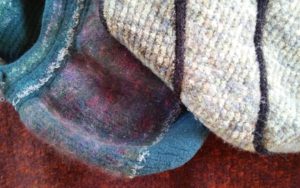 Wool shrinks, wool is scratchy, and wool is expensive. These are just a few of the comments I have heard from people as to why they have never worked with a yarn other than acrylic. I will admit, I use to feel that way too, until I learned more about it.
Wool shrinks, wool is scratchy, and wool is expensive. These are just a few of the comments I have heard from people as to why they have never worked with a yarn other than acrylic. I will admit, I use to feel that way too, until I learned more about it.
Let us address why wool shrinks. The shrinking process is called felting, it occurs when the individual fibers attach together. Each strand of fiber has scales, similar to the images that you have seen on hair conditioner commercials, where is shows a strand of hair with overlapping scales down the shaft, this is the same with wool. When wool fibers are rubbed together these scales will catch on each other and pull closed together, I think of it as holding hands, and this causes the individual fibers to pull closer together. As each individual strand does this, the overall size of the piece will shrink, because all of the individual strands are closer together.

Felted handbags… If you can still see the stitches, there is definitely more felting that can be done.
However, just because it can be simply stated does not mean that it happens easily, or equally. Some sheep breeds result in wool that felts much easier than others, but as the yarn ball usually only says “wool” it is hard to know exactly how that yarn will behave.
Many believe that getting wool wet, or getting it hot causes it to felt, when in reality it is agitation. By rubbing the fibers together you can cause them to felt, in a sense, the little “pills” you sometimes find after wearing are small versions of felting. These are fibers that have been rubbed together and have worked free of the yarn and formed a matted group that does not come apart. Water and heat can ease the felting process as they both help the scales open up, so it is easier for them the catch hold of one another, adding soap to this process can facilitate it even more, but without rubbing the scales will not felt.
Simply placing an item in the dryer will not cause it to felt, it really already felted in the washing machine as the drum agitated the clothing, the dryer just sped up the visual process by drying it. Unfortunately though, once wool has felted, it cannot be undone.
Felting though is not necessarily a bad thing. If you plan on intentionally felting your creation, such as a handbag, you can create a fabric so dense that you do not need to line it, and yet nothing will fall out. There are even patterns that create slippers by felting your original work. When creating or working with patterns such as these, they will be created larger than the desired outcome, to know how much you need to know how much your wool will shrink. You begin by making a swatch, measure it, then wash it or treat it in the manner you are planning on felting it (personally I just throw it in the washing machine with some denim to give it the most agitation, and then the dryer. This process may give you inconsistent outcomes, but I kind of like surprises). After it has felted, measure the swatch again, and then compare these measurements to the original, the difference in the amount of surface area is the amount it shrinks, now adjust the end desired size upward accordingly.
Note that the felting process never really ends, you can continue to felt a wool item many times over, and it will continue to shrink, not usually as drastically as the first time, but the fibers can continue to get closer and closer after each agitation.
